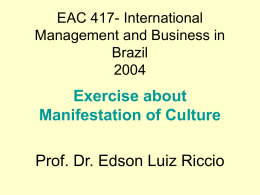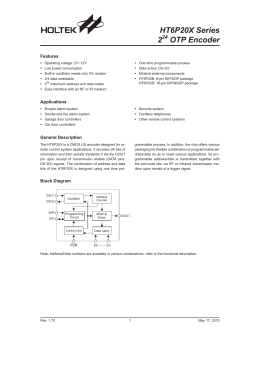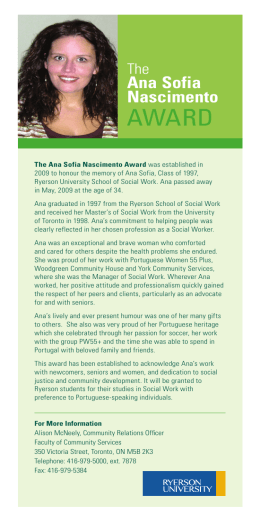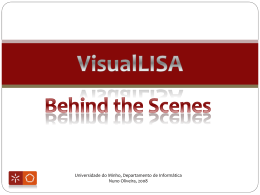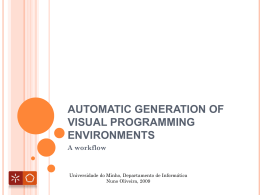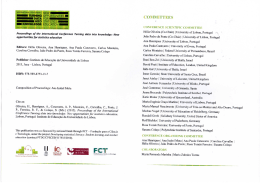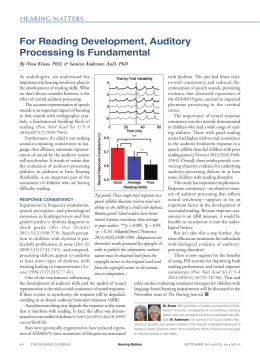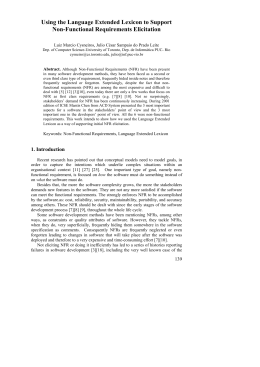Accepted Manuscript A new Optical Music Recognition system based on Combined Neural Network Cuihong Wen, Ana Rebelo, Jing Zhang, Jaime Cardoso PII: DOI: Reference: S0167-8655(15)00039-2 10.1016/j.patrec.2015.02.002 PATREC 6164 To appear in: Pattern Recognition Letters Received date: Accepted date: 5 May 2014 4 February 2015 Please cite this article as: Cuihong Wen, Ana Rebelo, Jing Zhang, Jaime Cardoso, A new Optical Music Recognition system based on Combined Neural Network, Pattern Recognition Letters (2015), doi: 10.1016/j.patrec.2015.02.002 This is a PDF file of an unedited manuscript that has been accepted for publication. As a service to our customers we are providing this early version of the manuscript. The manuscript will undergo copyediting, typesetting, and review of the resulting proof before it is published in its final form. Please note that during the production process errors may be discovered which could affect the content, and all legal disclaimers that apply to the journal pertain. ACCEPTED MANUSCRIPT Highlights • We propose a new OMR system to recognize the music symbols without segmentation. • A new classifier named Combined Neural Network(CNN) is presented. • Tests conducted on fifteen pages of music sheets show that the proposed method constitutes an interesting contribution to OMR. AC CE PT ED M AN US CR IP T • The Combined Neural Network(CNN) offers superior classification capability. ACCEPTED MANUSCRIPT 1 Pattern Recognition Letters journal homepage: www.elsevier.com A new Optical Music Recognition system based on Combined Neural Network a College b INESC of electrical and information engineering, Hunan University, Changsha 410082, China Porto, Universidade do Porto, Porto, Portugal CR IP T Cuihong Wena,∗∗, Ana Rebelob , Jing Zhanga, Jaime Cardosob ARTICLE INFO ABSTRACT Article history: Optical Music Recognition (OMR) is an important tool to recognize a scanned page of music sheet automatically, which has been applied to preserving music scores. In this paper, we propose a new OMR system to recognize the music symbols without segmentation. We present a new classifier named Combined Neural Network(CNN) that offers superior classification capability. We conduct tests on fifteen pages of music sheets, which are real and scanned images. The tests show that the proposed method constitutes an interesting contribution to OMR. c 2015 Elsevier Ltd. All rights reserved. AN US Communicated by S. Sarkar M Keywords: Neural network Optical music recognition Image processing 1. Introduction AC CE PT ED A significant amount of musical works produced in the past are still available only as original manuscripts or as photocopies on date. The OMR is needed for the preservation of these works which requires digitalization and should be transformed into a machine readable format. Such a method is one of the most promising tools to preserve the music scores. In addition, it makes the search, retrieval and analysis of the music sheets easier. An OMR program should thus be able to recognize the musical content and make semantic analysis of each musical symbol of a musical work. Generally, such a task is challenging because it requires the integration of techniques from some quite different areas, i.e., computer vision, artificial intelligence, machine learning, and music theory. Technically, the OMR is an extension of the Optical Character Recognition (OCR). However, it is not a straightforward extension from the OCR since the problems to be faced are substantially different. The state of the art methods typically divide the complex recognition process into five steps, i.e., image preprocessing, staff line detection and removal, music symbol segmentation, music symbol classification, and music notation reconstruction. Nevertheless, such approach is intricate because ∗∗ Corresponding author: Tel.: +86-13467672358; e-mail: [email protected] (Cuihong Wen) Fig. 1. Proposed architecture of the OMR system. it is burdensome to obtain an accurate segmentation into individual music symbols. Besides, there are numerous interconnections among different musical symbols. It is also required to consider that the writers have their own writing preference for handwritten music symbols. In this paper we propose a new OMR analysis method that can overcome the difficulties mentioned above. We find that the OMR can be simplified into four smaller tasks, which has been showed in Figure1. Technically, we merge the music symbol segmentation and classification steps together. The remainder of this paper is structured as follows. In Sec- ACCEPTED MANUSCRIPT 2 tion 2 we review the related works in this area. In Section 3 we describe the preprocessing steps, which prepare the system we will study on. Section 4 is the main part of this paper. In this section we focus on the music symbol detection and classification steps. We will discuss and summarize our conclusions in the last two sections. Fig. 2. Before Staff line removal 2. Related works Fig. 3. After Staff line removal CR IP T edge. These four lines form a box that define the boundary of the score area. Finally, we remove the black pixels outside the box. 3.2. Staff line detection and removal Staff line detection and removal are fundamental stages on the OMR process, which have subsequent processes relying heavily on their performance. For handwritten and scanned music scores, the detection of the symbols are strongly effected by the staff lines. Consequently, the staff lines are firstly removed. The goal of the staff line removal process is to remove the lines as much as possible while leaving the symbols on the lines intact. Such a task dictates the possibility of success for the recognition of the music score. Figure 3 is an example of staff line removal for Figure 2. To be specific, the staves are composed of several parallel and equally spaced lines. Staff line height (Staff line thickness) and staff space height (the vertical line distance within the same staff) are the most significant parameters in the OMR, see Figure4. The robust estimation of both values can make the subsequent processing algorithm more precise. Furthermore, the algorithm with these values as thresholds are easily adapted to different music sheets. In (I Fujinaga, 2004), staff line height and staff space height are estimated with high accuracy. The work developed in (Jaime S. Cardoso and Ana Rebelo, 2010) presented a robust method to reliably estimate the thickness of the lines and the interline distance. CE PT ED M AN US Most of the recent work on the OMR include staff lines detection and removal (I Fujinaga, 2004; J. S. Cardoso et al., 2009; Ana Rebelo and Jaime S. Cardoso, 2013; C. Dalitz, 2008), music symbol segmentation(F. Rossant and I. Bloch, 2007; Forns et al., 2005) and music recognition system approaches(G. S. Choudhury et al., 2000). Recently, (Ana Rebelo et al., 2013) proposed a parametric model to incorporate syntactic and semantic music rules after a music symbols segmentation’s method. (Florence Rossant, 2002)developed a global method for music symbol recognition. But the symbols were classified into only four classes. A summary of works in the OMR with respect to the methodology used was also shown in (Ana Rebelo et al., 2012). There are several methods to classify the music symbols, such as the Support Vector Machines(SVM), the Neural Networks (NN), the k-Nearest Neighbor(k-NN) and the Hidden Markov Models(HMM). For comparative study, please see (Ana Rebelo et al., 2010). However, it is worthy to note that the operation of symbol classification can sometimes be linked with the segmentation of the objects from the music symbols. In (L. Pugin, 2006), the segmentation and classification are performed simultaneously using the Hidden Markov Models (HMM). Although all the above mentioned approaches have been shown to be effective in specific environments, they all suffer from some limitations. The former (Ana Rebelo et al., 2010) is incapable of obtaining an output with a proper probabilistic interpretation with the SVM and the latter (L. Pugin, 2006) suffers from unsatisfactory recognition rates. In this paper, we simplify all the process and also overcome the issues inherent in sequential detection of the objects, leading to fewer errors. What is more, we propose a new Combined Neural Network(CNN) classifier, which has the potential to achieve a better recognition accuracy. 3. Preprocessing steps AC Before the recognition stage, we have to take two fundamental preprocessing steps, i.e., image pre-processing and staff line detection and removal. 3.1. Image pre-processing The image pre-processing step consists of the binarization and noise removal process. First, the images are binarized with the Otsu threshold algorithm(N. Otsu, 1979). Then we remove the noise around the score area. The boundary of the score area is estimated by the connect components. We find the first and the last staff lines in the music sheet. At the same time, we choose the minimum start point of the score area as the left edge and the maximum end point of the score area as the right Fig. 4. Staff Line Height and Space Height In (J. S. Cardoso et al., 2009), a connected path algorithm for the automatic detection of staff lines in music scores was proposed. It is naturally robust to broken staff lines (due to lowquality digitization or low-quality originals) or staff lines as thin as one pixel. Missing pieces are automatically completed by ACCEPTED MANUSCRIPT 3 Fig. 6. The structure of the MLP. the algorithm. In this work, staff line detection and removal is carried out based on a stable path approach as described in (J. S. Cardoso et al., 2009). resized to 35*20 pixels and then converted to a vector of 700 binary values. At the same time, the images of the input 3 are resized to 60*30 pixels and then converted to a vector of 1800 binary values. We give them different sizes in order to obtain different neural networks. Later the classification of three neural networks could be combined. We choose these values in proportion with the aspect ratio of bounding rectangles of the symbols. The shapes of most music symbols are similar to one of the following shapes. 4. Music symbol classification and detection M AN US This section is the main part of the paper, which consists of the study of music symbol detection and classification. We firstly split the music sheets into several blocks according to the positions of the staff lines. A set of horizontal lines are defined, which allow all the music symbols in the blocks. After the decomposition of the music image, only one block of the music score will be processed at a time. For example, Figure 2 is a block from a page of music sheet. The CNN will be used as the classifier. And the detection of the symbols are started with the method of connect components. These will be described in the following two subsections. CR IP T Fig. 5. The structure of the CNN PT ED 4.1. Music symbol classification As mentioned before, the classification of the music symbols in this paper is based on a designed CNN. In this section, more details about the CNN will be described. AC CE 4.1.1. Proposed architecture of the CNN A theory of classifier combination of Neural Network was discussed in(Dar-Shyang Lee., 1995). Our CNN is based on the theory of (Dar-Shyang Lee., 1995). The main idea behind is to combine decisions of individual classifiers to obtain a better classifier. To make this task more clearly defined and subsequent discussions easier, here we describe the architecture of the CNN in Figure 5. The three identity neural networks in Figure 5 will be introduced in the following subsection, each of them is a Multi-layer Perception (shorted as MLP, see Figure 6 for detail). And the other focus of the CNN is how the information presented in output vectors affects combined performance. This can be easily achieved by applying different majority vote functions. 4.1.2. The Inputs Firstly, each music symbol image is converted to a binary image by thresholding. Then the images are resized. For input1, the images are resized to 20*20 pixels and then converted to a vector of 400 binary values. For input 2, the images are • 20*20: semibreve(e.g. • 35*20: flat(e.g. • 60*30: notes(e.g. ), accents (e.g. ),rest(e.g. ) ) ), notes flags (e.g. ). 4.1.3. Multi-layer Perceptron (MLP) The MLP inside each of the three Neural Networks in Figure 5 is introduce in Figure 6. It is a type of feed-forward neural network that have been used in pattern recognition problems (F.Rosenblatt, 1957). The network is composed of layers consisting of various number of units. Units in adjacent layers are connected through links whose associated weights determine the contribution of units on one end to the overall activation of units on the other end. There are generally three types of layers. Units in the input layer bear much resemblance to the sensory units in a classical perceptron. Each of them is connected to a component in the input vector. The output layer represents different classes of patterns. Arbitrarily many hidden layers may be used depending on the desired complexity. Each unit in the hidden layer is connected to every unit in the layer immediately above and below. The Multi-layer Perceptron model can be represented as aj = n X i=1 g(a j ) = w ji xi + w j0 , j = 1, · · ·, H. (1) 1 1 + exp(−a j ) (2) ACCEPTED MANUSCRIPT 4 Accent BassClef Beam Flat natural Note NoteFlag NoteOpen RestI RestII Sharp TimeN TrebleClef TimeL AltoClef Noise Breve Semibreve M ED PT CE AC 4.1.5. Majority vote In each neural network inside the CNN, there is one output which represents the corresponding class of the input image. Dots Barlines Table 2. Full set of the music symbols of CNN NETS 5. vertical lines note groups dots and note heads AN US 4.1.4. Database and Training A data set of both real handwritten scores and scanned scores is adopted to perform the CNN. The real scores consist of 6 handwritten scores from 6 different composers. As mentioned, the input images are previously binarized with the Otsu threshold algorithm(N. Otsu, 1979). In the scanned data set, there are 9 scores available from the data set of (C. Dalitz, 2008), written on the standard notation. A number of distortions are applied to the scanned scores. The deformations applied to these scores are curvature, rotation, Kanungo and white speckles, see(C. Dalitz, 2008) for more details. After the deformations, we have 45 scanned images in total. Finally, more than ten thousand music symbol images are generated from 51 scores. The training of the networks is carried out under Matlab 7.8.Several sets of symbols are extracted from different musical scores to train the classifiers. Then the symbols are grouped according to their shapes and a certain level of music recognition is accomplished. For evaluation of the pattern recognition processes, the available data set is randomly split into three subsets: training, validation and test sets, with25%, 25% and 50% of the data, respectively. This division is repeated 4 times in order to obtain more stable results for accuracy by averaging and also to assess the variability of this measure. No special constraint is imposed on the distribution of the categories of symbols over the training, validation and test sets. We only guarantee that at least one example of each category is present in the training set. Using the above method, we train two networks which named CNN NETS 20 and CNN NETS 5 respectively. The relevant classes for the CNN-NETS-20 used in the training phase of the classification models are presented in Table 1. The symbols are grouped according to their shapes. The rests symbols are divided into two classes, named RestI and RestII. And the relations are removed. We generate the noise examples from the reference music scores, which have the exact positions of all the symbols. We shift the positions a little to get the noise samples. Some of the samples are parts of the symbols, and some are the noises on the music sheet. In total the classifier is evaluated on a database containing 8330 examples divided into 20 classes Meanwhile, we have the other database for the training of CNN NETS 5. It is generated by applying the connect components technique to the music sheets. The objects are saved automatically. Then they are divided into five classes, which includes vertical lines, note groups, dots and note heads, noises, all the other symbols. For the last class, each symbol is belonging to one class of the CNN NETS 20. Table 2 shows the music symbols that have been used in the training of the CNN NETS 5. Table 1. Full set of the music symbols of CNN NETS 20. CR IP T where xi is the ith input of the MLP, w ji is the weight associated with the input xi to the jth hidden node. H is the number of the hidden nodes, w j0 is the biases. The activation function g(·) is a logistic sigmoid function. The training function updates weight and bias values according to the resilient back propagation algorithm. noise the other symbols Further more, the probability for the image being classified to a class is saved at the same time. As showed in Figure 5, the CNN will have three outputs for each input image. Then we repeat four times with different test sets that randomly generated. Finally we have twelve classification results. The combined performance depends on the choosing of the method for majority vote. In this paper, the main idea of the majority vote is to save all the twelve classification results together in a matrix and choose the most frequency value as the final output. In this work, the CNN classifiers are tested using test sets randomly generated. The average accuracy for CNN NETS 20 is 98.13% and for CNN NETS 5 is 93.62%. Both two nets are saved for the classification of all the symbols during the music detection. 4.2. Music symbol detection After saving the CNN nets, we detect the music symbols and classify them using the nets. As previously mentioned, the music sheets are split into several blocks. Firstly, we obtain the individual objects from the music score blocks using connect components technique. Connect components means that the black pixels connected with the adjacent pixels would be recognized as one object. It is worthy to notice that the threshold should be defined properly. It should be big enough to keep the symbols completed and be small enough to split the nearest symbols. Breadth first search technique which aims to expand and examine all nodes of a graph and combination of sequences by systematically searching through every solution is used. The threshold of breadth first search is set as 5, which means that if the distance between two black pixels is below 5, they would be counted as one object. Then we saved the positions of all the ACCEPTED MANUSCRIPT AN US CR IP T 5 Fig. 7. The processing flow of the music symbol detection symbol. It would be a barline only if the height of the new symbol is no less than 4*spaceHeight. ED M objects for the subsequent process. The process flow is showed in Figure 7. As showed in the processing flow, firstly we take a preliminary classification for the objects using CNN NETS 5. The symbols are divided into five basic classes, including vertical lines, rannote groups, dots and note heads, noises, all the other symbols. Then we processed the symbols in each class independently. More processing details of each class are given in the following five subsections. AC CE PT 4.2.1. Find symbols along the vertical lines Most of the vertical lines come from barlines. But some of them come from the broken notes stems and the vertical lines of flats. We can distinguish them from the height of the vertical line. It would be a barline if the height of the line is as high as 4*spaceHeight. Else the line could be a broken symbol. Here we find symbols around the area of this line. Two analysis windows are applied to the object respectively. The window size could be defined properly according to the space height. The height of the note stems or barlines is approximately equal to 4*spaceHeight. And the width of these symbols is usually around 2*spaceHeight. Figure 8 shows the size of the window and how the window works. It should be observed that when we save the symbols according to the value of class, there is an exception when the class is barline. Because the CNN classify the symbols basing on their shapes, and the symbols are resized when being given to the CNN. It can not distinguish from . Consequently, even the class is barline, we need to see the height of the new Fig. 8. Find symbols along vertical lines 4.2.2. Analysis of note groups connected with beams Note groups are the symbols that the note stems are connected together by the same beam, see Table 2. The symbols inside these groups are very difficult to be detected and classified as primitive objects, since they dramatically vary in shape and size, as well as they are parts of composed symbols. The symbols are interfere with staff lines and be assembled in different ways. Thus, we propose a solution to analyze the symbols based on a sliding window. An analysis window is moved along the columns of the image in order to analyze adjacent segments and keep only the ACCEPTED MANUSCRIPT 6 notes. The sizes of the most of the notes are between some particular values. Generally, the Height is not smaller than 3*spaceHeight, and the width is about 2*spaceHeight. Fig. 9. Find symbols through the Column Subsection (4.2.1). Figure 11 shows how to find the notes or note flags from the note head. 4.2.4. The processing of noise In order to prevent symbols missing due to primitive recognition failures, all the noise symbol in this phase are called back for further processing. As a unique feature of the music notation, in most cases, the symbol must be above or below the noise symbol if the noise is a part of the symbol. The same method that used to find notes by the positions of the note heads can be applied to the noises, too. The difference is when saving the symbol, the class is no longer limited to note or note flag. It can be anyone of the twenty classes except noises ED M AN US Figure 9 shows the size of the bounding box and how it works. In order to avoid missing some notes, the step is set smaller than the width, which means that there is an overlap between two windows. Then we change the window size to find the beams and smaller symbols such as sharps and naturals. The sliding window goes through the columns first, then goes through the rows. As the size s of the beams and the sharps are quite different, we use the window height as a seed of a region growing algorithm. At the same time, the window width is set as 2*spaceHeight because both the beams and the sharps widths are around that value. Figure 10 shows the window size and how it works. From Figure 10, we can see that the relevant music symbol is isolated and precisely located by the bounding box. The sharps between the notes are considered, too. CR IP T Fig. 11. Find symbols from the note heads. 4.2.5. The processing of the other symbols As mentioned in the training of the CNN NETS 5, the fifth class of the objects is the other symbols. Each symbol in this class is belonging to one class of the CNN NETS 20. Therefore, at this step, all the symbols in this class are classified by CNN NETS 20. Then the positions and classes of the symbols are saved for the grouping and final accuracy calculating. PT Fig. 10. Find symbols through the Column and rows. AC CE 4.2.3. The processing of dots and note heads Dots are symbols attributed to notes. There are two kinds of dots. If the dots are bellow and above the note heads, they are accent dots. On the other hand, if the dots are placed to the right of note heads or in the center of a space, they are duration dots. They can be distinguished using the music prior knowledge. In this paper, this difference is not considered. Our result is based on the assumption that both of them belong to the same class named dots. In this phase, the first step is classifying the dots and the note heads. It is not a good idea to classify them by the CNN because they have the similar shape. The solution is to distinguish them from their sizes. If both the height and the width of the symbol are smaller than spaceHeight, it is a dot. Otherwise, they symbol is a note head. In the second step, we find the notes according to the positions of the note heads using similar technique as the symbols are found around the vertical lines in 4.3. Group symbols All the symbols have been saved together. For the purpose of avoiding repetitive symbols, the relative positions of the symbols can be modeled and introduced at a higher level to group the symbols we saved during the previous steps. Basically, the symbols from the same class are compared with each other. The symbols will be saved as one symbol if their positions are close enough. 5. Results and discussions Three metrics were considered: the accuracy rate, the average precision, and the recall. They are given by tp + tn tp + f p + f n + tn tp precision = tp + f p tp recall = tp + f n accuracy = ACCEPTED MANUSCRIPT 7 Table 4. The results trying to balance all the metrics Table 3. The Results of the OMR system precision% 55.31 64.53 73.57 72.92 63.02 26.13 43.75 57.15 64.14 57.84 92.59 96.83 66.32 32.46 53.19 100.00 73.57 64.13 recall% 94.07 95.66 95.44 94.78 97.22 87.68 98.63 93.32 83.13 93.33 88.80 85.93 98.47 94.12 95.34 73.27 89.32 91.72 images img01 img02 img03 img04 img05 img06 img07 img08 img09 Average of scanned img10 img11 img12 img13 img14 img15 Average of real Average of all , CE PT ED M where tp indicates the amount of true positives, tn indicates the amount of the true negatives, fn indicates the amount of the false negatives, and fp indicates the amount of the false positives. A true positive is obtained when the algorithm successfully identifies a musical symbol in the score. A true negative means the algorithm successfully removes a noise in the score. A false negative happens when the algorithm fails to detect a music symbol present in the score. And a false positive means that the algorithm falsely identifies a musical symbol which is not one. These percentages are computed using the symbol positions and class reference obtained manually and the symbol positions obtained by the segmentation algorithm. The performance of the procedure can be seen in Table 3 . As illustrated in the Table 3, the average accuracy is as high as 96.73%, and the recall reaches 91.72%. It means that most of the symbols are successfully recognized by our algorithm(e.g. , ). But the precision seems not very high, only AC 64.13%, where a lot of noise are identified as symbols. The low precision is due to the fact that during the analysis of the note groups connected with the beams the moving windows are used. Such moving windows generate a lot of noise(e.g. , ). Besides, sometimes the symbols are split by the bounding box or composed with other symbols(e.g. , accuracy % 98.19 98.22 98.83 98.91 98.78 99.34 99.30 98.42 98.18 98.69 99.40 99.53 98.71 99.30 99.46 96.12 98.75 98.71 precision% 78.13 80.31 100.00 95.90 91.23 99.07 95.91 86.13 100.00 91.85 100.00 100.00 72.83 86.84 100.00 100.00 93.28 92.42 CR IP T accuracy% 95.51 96.76 97.08 97.51 96.42 93.07 94.78 95.16 96.37 95.85 99.43 99.49 98.29 95.41 97.49 98.22 98.05 96.73 AN US images img01 img02 img03 img04 img05 img06 img07 img08 img09 Average of scanned img10 img11 img12 img13 img14 img15 Average of real Average of all recall % 94.34 91.73 84.89 86.41 88.78 77.54 87.28 90.39 69.19 85.62 80.87 84.65 97.85 83.19 81.36 41.82 78.29 82.69 there is a note like . After the connected components, it is and . We find symbols along the vetical line split into and get a note from the note head . At the same time, we find symbols and get a note , too. The aim of our work is to get high accuracies for all the three metrics, get more true positives and few noise. To achieve this goal, another test has been taken. We try to remove the noise generated from the bounding box and change the threshold in the group symbols step(e.g. The mentioned note will be one symbol when the threshold is big enough). As showed in Table 4, the performance changed a lot. Firstly, the average accuracy reached 98.71%. It means our algorithm can make accurate judgment for an object to be a symbol or a noise. Secondly, the precision greatly increased to 92.42%, which means most of the noise are removed successfully(e.g. We set restrictions when save the ). These are the symbols like main false positives. At the same time, in order to avoid false negatives, we found symbols along both stems and note heads. There would be considerable repeated notes, too. For example, , , ). However, with the increase of the precision, the recall decreased to 82.69%. During the removing of the noise, some of the symbols are falsely identified ACCEPTED MANUSCRIPT 8 References Pugin,2006 This paper Fmix% 97.11 Average of all% 98.71 Wfs % 97.42 Scanned% 98.69 as the noises and be removed(e.g.note Wmf % 96.22 Real% 98.75 from this group M AN US is regarded as a noise and removed because of its height. All in all, the precision is to some extent in conflict with the recall. When the recall increased, more objects are recognized as symbols, including some of the noises, which lead to the decrease of the precision. On the contrary, the precision obviously improved when the recall reduced. The proposed algorithm has the limitation to obtain a perfect result both for precision and recall. The proposed algorithm has the limitation to obtain a perfect result for both precision and recall. Due to different applications, the training stages, and the testing sets of data, comparison between the performance of our proposed network and those of the others mentioned is difficult. However, we compare our results with the ones in (L. Pugin, 2006). It’s worth noting that the results were obtained in different experimental conditions and on different data sets. Based purely on the recognition accuracy, our network outperforms Pugin’s network. Table 5 is the comparison of the recognition rates. Ana Rebelo, Jaime S. Cardoso, Staff line Detection and Removal in the Grayscale Domain. In Proceedings of the International Conference on Document Analysis and Recognition (ICDAR), 2013 Ana Rebelo, Ichiro Fujinaga, Filipe Paszkiewicz, Andre Marcal, Carlos Guedes, Jaime S. Cardoso, Optical Music Recognition: State-of-the-Art and Open Issues. In International Journal of Multimedia Information Retrieval, Springer-Verlag, volume 1, 2012. Ana Rebelo, Filipe Paszkiewicz, Carlos Guedes, Andre R. S. Marcal, Jaime S. Cardoso. A Method for Music Symbols Extraction based on Musical Rules. Proceedings of BRIDGES. 81-88,2011. Ana Rebelo, Andre Marcal, Jaime S. Cardoso, Global constraints for syntactic consistency in OMR: an ongoing approach. In Proceedings of the International Conference on Image Analysis and Recognition (ICIAR) Ana Rebelo, Artur Capela, Jaime S. Cardoso, Optical recognition of music symbols: A comparative study, International Journal on Document Analysis and Recognition, vol. 13, pp. 19C31, 2010. C. Dalitz, M. Droettboom, B. Czerwinski, and I. Fujigana. A comparative study of staff removal algorithms, IEEE Transactions on Pattern Analysis and Machine Intelligence, vol. 30, pp. 753C766, 2008 Dar-Shyang Lee.A THEORY OF CLASSIFIER COMBINATION:THE NEURAL NETWORK APPROACH.Dissertation of Faculty of the Graduate School of State University of New York at Buffalo in partial fulfillment of the requirements for the degree of Do ctor of Philosophy.1995 F. Rossant and I. Bloch, Robust and adaptive omr system including fuzzy modeling, fusion of musical rules, and possible error detection, EURASIP Journal on Advances in Signal Processing, vol. 2007, no. 1. 160C160, 2007. Florence Rossant, A global method for music symbol recognition in typeset music sheets.Pattern Recognition Letters 23 (2002) 1129C1141 F.Rosenblatt. The perceptron : A perceiving and recognizing automaton.Cornell Aeronaut. Lab Report, 85-4601-1, 1957. Forns, A., Llads, J., Snchez, G.: Primitive segmentation in old handwritten music scores. In Liu, W., Llads, J., eds.: GREC. Volume 3926 of Lecture Notes in Computer Science., Springer (2005) 279-290 G. S. Choudhury, M. Droetboom, T. DiLauro, I. Fujinaga, and B. Har-rington, Optical music recognition system within a large-scale digitization project, in International Society for Music Information Retrieval (ISMIR 2000), 2000. I Fujinaga. Staff Detection and Removal. In S. George (editor), Visual Perception of Music Notation, 1-39, 2004. J. S. Cardoso, A. Capela, A. Rebelo, C. Guedes, and J. P. da Costa, Staff detection with stable paths, IEEE Transactions on Pattern Analysis and Machine Intelligence, vol. 31, no. 6, pp. 1134C1139, 2009. Jaime S. Cardoso, Ana Rebelo, Robust staffline thickness and distance estimation in binary and gray-level music scores. L. Pugin, Optical music recognition of early typographic prints using Hidden Markov Models, in International Society for Music Information Retrieval (ISMIR), 53C56, 2006. N. Otsu. A threshold selection method from gray-level histograms. IEEE Transactions on Systems, Man and Cybernetics, 9(1):62C66, 1979. CR IP T Table 5. Comparison of the recognition rates ED 6. Conclusions and Future work AC CE PT A method for music symbols detection and classification in handwritten and printed scores was presented. Our method does well at recognizing music symbols from the music sheets. We classify the symbols basing on the proposed new CNN, whose performance is excellent. The results could be better if we integrate as much as priori knowledge as possible. When the symbols are grouped in the last step, music writing rules including contextual information relative position rules is helpful to reduce the symbols confusion. For the processing of the note groups connected with beams, the projection approach may also lead to better performance. Further investigations could include the improvement of the classifier by defining a more specific neural network for the music symbols, and the development of a better recognition system by applying the above possible solutions . Acknowledgments This work is financed by Fund of Doctoral Program of the Ministry of Education (Approval No.20110161110035) and China National Natural Science Foundation (Approval No. 61174140,61203016 and 61174050). Supplementary Material
Download
